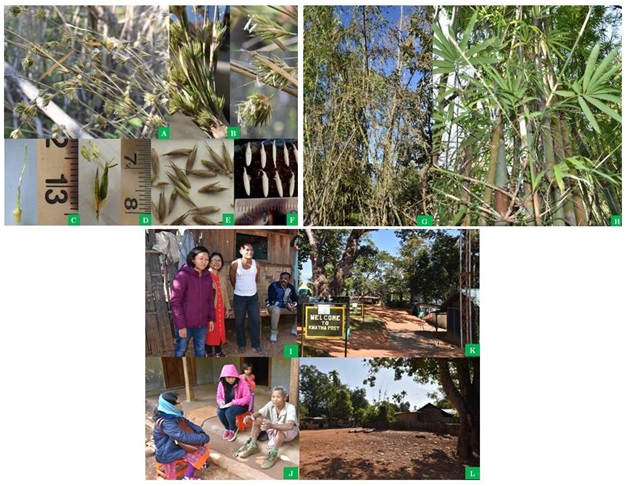
Evanylla Kharlyngdoh
Scientist Name: Evanylla Kharlyngdoh, Ph.D.
Designation/Position: Scientist-C (Ecology/Environmental Science/Climate Change) Contractual
Department/Programme Name: Plant Resources Division
Academic Qualifications
• 2005-2010 Ph.D. in Botany (Awarded in 2012), North-Eastern Hill University, Shillong, Meghalaya.
• 2001-2003, M.Sc. Botany (Specialization in Plant Biotechnology), North-Eastern Hill University, Shillong, Meghalaya.
• 1998-2001, B.Sc. (Botany Hons.), St Mary’s College, Shillong, Meghalaya
Experience
• 2018 till date, Scientist–C (Ecology/Environmental Science/Climate Change) (Contractual basis), Institute of Bioresources and Sustainable Development (IBSD), A National Institute under Department of Biotechnology (DBT), Ministry of Science & Technology, Govt. of India, 6th Mile, Upper Shillong, Meghalaya.
• 2016–2018, Scientist–C (Ecology/Environmental Science/Climate Change) (Contractual basis), Institute of Bioresources and Sustainable Development (IBSD), A National Institute under Department of Biotechnology (DBT), Ministry of Science & Technology, Govt. of India, Imphal, Manipur.
• 2015–2016, Project Scientist–B (Contractual basis), Meghalaya Climate Change Centre, under MBDA, Funded by DST, Govt. of India under National Mission on Sustainable Himalayan Eco System (NMSHE).
• 2014–2015, Project Scientist (Contract basis), Department of Botany, NEHU, Shillong, Funded by the Govt. of Arunachal Pradesh.
• 2012–2014, Research Associate, Department of Botany, NEHU, Shillong, Funded by DBT, Ministry of Science and Technology, Govt. of India, CGO Complex, Lodhi Road, New Delhi.
• 2011–2012, Senior Technical Assistant, Department of Botany, NEHU, Shillong, Funded by DBT, Ministry of Science and Technology, Govt. of India, CGO Complex, Lodhi Road, New Delhi.
• 2003–2004, Research Assistant, Community Forest Management Working Group (CFMWG) Secretariat, North–East India, Funded by the Community Forestry International Inc., USA.
Awards & Fellowships
• 2005–2010: Rajiv Gandhi National Junior and Senior Research Fellowship for Ph.D. programme, under the Department of Botany, NEHU, Shillong, Funded by the University Grants Commission, Selection and Award Bureau, South Campus, Delhi University, Benito Juarez Marg, New Delhi.
• 2009: Brandis Prize for the best research paper entitled “Taxonomic identity, ecological niche and distribution of two restricted range bamboo species of Meghalaya–Phyllostachys mannii Gamble and Sinarundinaria griffithiana (Munro) C.S. Chao & Renvoize” in the field of Forest Silviculture, by the Indian Forester.
Memberships (Professional Associations / Societies)
• 2008–2009: Member of “LEAD (Leadership for Environment and Development) Climate Change Leader” (graduated in 2009) under a joint programme of LEAD India and British High Commission, under the Eastern Himalayan Climate Change Leaders’ Programme, The Missing Link (MTL–India) and Eastern Himalayan Decentralized Resource Centre (EHDRC).
• Life Member of Indian Science Congress, India.
Specialized Training
• August 2008–August 2009, Eastern Himalayan Climate Change Leaders’ Programme, Organised by The Missing Link (TML–India) and the Eastern Himalayan Decentralized Resource Centre (EHDRC), New Delhi. Subject learned: Climate Change.
• August–September, 2009, Short term training course in data analysis, Organised by Computer Centre, NEHU, Shillong Meghalaya. Statistical Softwares used: MS–Excel, XL–Stat, STATISTICA, ORIGIN.
• 21–23 March, 2014, Ecological niche modelling, Organised by Department of Botany, NEHU, Shillong, Meghalaya. Softwares used: MS–Excel, MAXent, Arc–View, DIVA–GIS, PAST.
• 21–30 April, 2015, Adaptation and mitigation options for climate resilient agriculture, Organised by ICAR Research Complex for NEH Region, Umiam, Meghalaya.
1. Research theme photo

2. Verticals involved
• Vertical 2: Ethnobotany, Ethnopharmacology and Drug Discovery
• Vertical 7: Eco-Restoration
3. Research Area/Research Expertise
• Ecological research and sustainable utilization of food based NTFPs
• Processing and value addition of wild/semi-wild/lesser known food based plant species
• Climate Change/Ecological niche modelling
4. Research Summary
A. Current Research:
1. Development of database and value addition of bamboos of Northeast region:
In Northeast region about 16 genera and 89 bamboo species grow in the tropical and subtropical regions. The current status of bamboo growing are in this region is estimated to be 53,538 km2 which constitutes 31.4% of the total forest cover of Northeast region and 7.5% of the country’s total forest cover (FSI, 2019). Unfortunately, as forest ecosystems shrink under human pressure, coupled with erratic and unusual bamboo flowering habit, bamboo species diversity particularly those which are restricted to a certain geographical area are likely to be under threat. Many bamboo habitats are also intrinsically vulnerable to flowering events and subsequent death of the entire populations over wide areas at intervals ranging from 3–120 years (Janzen, 1976; Bystriakova et al. 2003). In India, flowering cycles of bamboos have been reported only in 20 species (Seethalakshmi and Kumar, 1998). Nearly 60% of the bamboo species still lacks flowering information. Although reports on incidence of flowering are available in several published literatures, most of these information are scattered and unsystematic. In order to fully understand the biological and ecological characteristics of a flowering bamboo species, detailed flowering information is required.
Outcome: A comprehensive database of all bamboo species of Northeast India is being prepared mainly through primary and secondary sources. Data includes their distribution, morphology, ecological characteristics, uses and detailed flowering period. This information will be of huge advantage in calculating their life cycle that would further be useful in sustainable management and conservation of their natural habitats. Figure 1 shows some of the photographs of bamboo species collected from Northeast states.

Fig 1: Bamboo species of Northeast region
2. Development of database and value addition of wild/semi-wild indigenous edible fruits of Northeast Region:
Northeast region is highly rich in many wild and semi-wild indigenous edible fruit crops that are of great value in terms of nutrition and medicine. These crops are not only nutritionally and medicinally rich but also thrive well under a broad climatic niche that would be very helpful to sustain their growth and production with changing climatic conditions. In spite of their potential, these edible fruit species are utilised only at local level and therefore have not gain much attention both at scienti?c and farmers level. In order to enhance their importance and utility, development of sustainable bioresource products through value addition is needed, so that fruits quality are extended and socio-economic conditions of the farmers is improved.
Outcome: A list of all wild and semi-wild indigenous edible fruit species of Northeast region is being collected and compiled through primary and secondary sources (Figure 2). The list includes data such as their distribution, habitat, morphological and phenological description, uses and market value. Further, ecological research will be carried out on priority species, and its utilization through value addition will be developed.

Fig 2: Collection of wild, semi-wild indigenous edible fruit species of Northeast region
3. Value addition of Elaeagnus latifolia Linn. (Sohshang), a semi-wild indigenous edible fruit of Northeast region:
A study was carried out at IBSD, Upper Shillong, Meghalaya during the year 2019 with an objective to diversify the processing methods to obtain different value added products of the fruit with extended shelf life.
Outcome: In this study, fresh fruits were processed as sun dried and oven dried sliced pulp as well as pickle using half-cut fresh, sun dried and oven dried sliced fruit (Figure 3). Standardize methods for processing and preparation of different value added products has been developed. 
Fig 3: Elaeagnus latifolia: fruiting plant (a), ripe fruits (b), seeds with seed coat (c) and without seed coat (d), dried sliced fruit (a), powdered pulp (b), chutney (c) and pickle (d)
B. Previous Notable Research:
1. Establishment of bamboo germplasm at National Bioresource Park, IBSD, Haraorou, Manipur:
In line with the IBSD mandate in conservation of bioresources, an emphasis was given to establish a germplasm bank for bamboo species of NE region.
Outcome: So far 7 bamboo species have been planted during the year 2016-2017 at National Bioresource Park, IBSD, Haraorou, Manipur (Figure 4).

Fig 4: Plantation and maintenance of bamboo species at National Bioresource Park, IBSD, Haraorou, Manipur
2. Ecological impacts of bamboo dominated mixed forest ecosystem during the flowering event of Cephalostachyum pergracile at Tengnoupal district, Manipur:
Flowering in bamboo is a botanical enigma and the life history of many bamboo species is still unknown because of its unusual flowering habit. Although incidence of flowering has been reported in many bamboo species, about 60% of the bamboo species still lacks flowering information. During 2014–2018, flowering of Cephalostachyum pergracile occurred at Tengnoupal district, Manipur during which the study was carried out (Figure 5). The objectives were to study the extent of flowering area, the change in biological characteristics and population structure of C. pergracile and the ecological impacts of the bamboo dominated mixed forest ecosystem during the flowering event, through field observations and traditional knowledge documentation.
Outcomes: Data on flowering area, morphological characteristics and population structure of C. pergracile, and ecological impacts on the natural forest ecosystem during the flowering event were recorded and documented.

Fig 5: Cephalostachyum pergracile Munro: Inflorescence (A); Cluster of pseudospikelets with fertile florets (B); Pistil with lodicule (C); Hairy spikelet with bracts and stamens (D); Floret with hairy lemma and palea (E and F); Flowered culms (G); Unflowered culms (H); Interaction with elder person on bamboo flowering incidence (I and J) at Kwatha village Tengnoupal district, Manipur (K and L).
• Research Articles
• Lynser MB, Tiwari BK, Nongbri B, Kharlyngdoh E (2014) Bamboo mat making and its contribution to the rural livelihood of women in south Meghalaya, India. Bamboo Science and Culture: The Journal of the American Bamboo Society 28(1): 1–9. ISSN 0197– 3789. https://bamboo.org/_uploads/pdfs/BSCv28.pdf
• Barik SK, Kharlyngdoh E, Naithani HB (2009) Taxonomic identity, ecological niche and distribution of two restricted range bamboo species of Meghalaya–Phyllostachys mannii Gamble and Sinarundinaria griffithiana (Munro) C.S. Chao & Renvoize. Indian Forester 135: 67–77. ISSN NO. 0019–4816. http://www.indianforester.co.in/index.php/indianforester/article/view/310
• Kharlyngdoh E, Barik SK (2008) Diversity, distribution pattern and use of bamboos in Meghalaya. Journal of Bamboo and Rattan 7 (1–2): 73–90. ISSN NO. 0973–4449. http://www.jbronline.org/archives.asp?Id=21
• Book Chapters
• Barik SK, Adhikari D, Kharlyngdoh E (2012) Ecological impact assessment and predictive modeling of bamboo flowering. In: Veena Tandon and Barik SK (Eds.), Bamboo Flowering and Rodent Control. Regency Publications, A Division of Astral International Pvt. Ltd., New Delhi, pp. 79–95. ISBN: 9788189233976. https://www.amazon.com/Bamboo-Flowering-Rodent-Control-Tandon/dp/9351306216
• Kharlyngdoh E, Adhikari D, Barik SK (2016) Modelling the distribution of a few lesser known bamboo species of Meghalaya and determining areas for their conservation. In: Upadhyaya K. (Ed.). Biodiversity and Environmental Conservation. Discovery Publishing House Pvt. Ltd., New Delhi, pp. 202–216. ISBN: 978–93–5056–775–3. https://www.amazon.com/Biodiversity-Environmental-Conservation-Krishna-Upadhaya/dp/935056775X
Group Photo: 
Group Members (Details):
|
1. |
Miss. Jenny Pearlcy Lyngdoh Pale, Project Fellow, IBSD Meghalaya (Core) Email: 18jennypale@gmail.com
Project title: Study of wild/semi-wild indigenous edible fruit crops of Northeast region
Expected Outcome: Development of database of all wild and semi-wild indigenous edible fruit crops of Northeast region that have high food and medicinal value and to enhance their importance and utility through value addition so that fruits quality are extended and socio-economic conditions of the farmers is improved. |
|
|
Previous Member |
||
|
1. |
Miss. Longing Basuk Langstieh, Project Fellow, IBSD Meghalaya (Core) Email: long_langstieh@yahoo.com
Project title: Value addition of Elaeagnus latifolia Linn. (Sohshang), an underutilized semi-wild indigenous edible fruit of Northeast region.
Expected Outcome: To extend the shelf life of the fruit by diversifying the processing methods and to obtain different value added products of the fruit with extended shelf life. |
|
• NA


